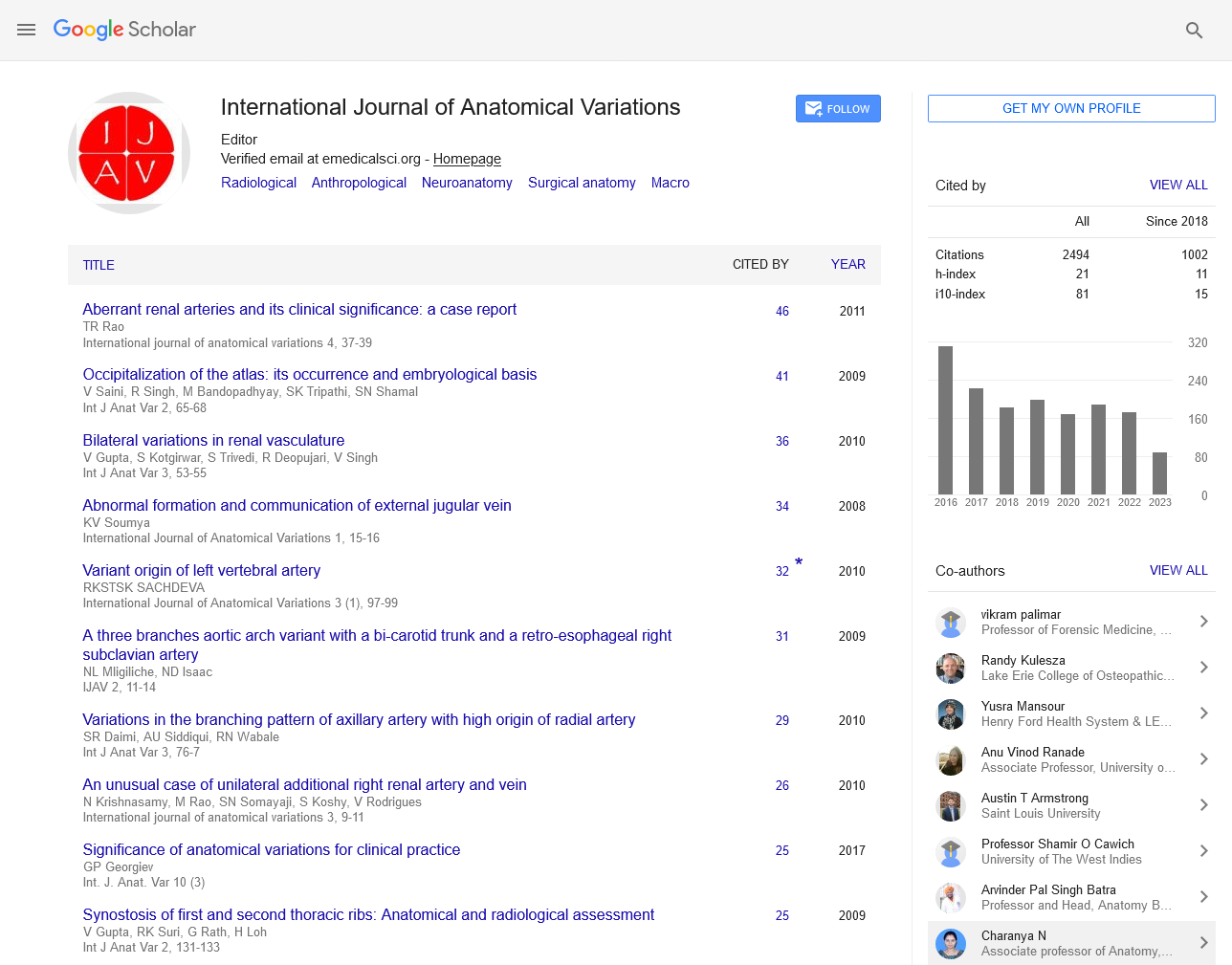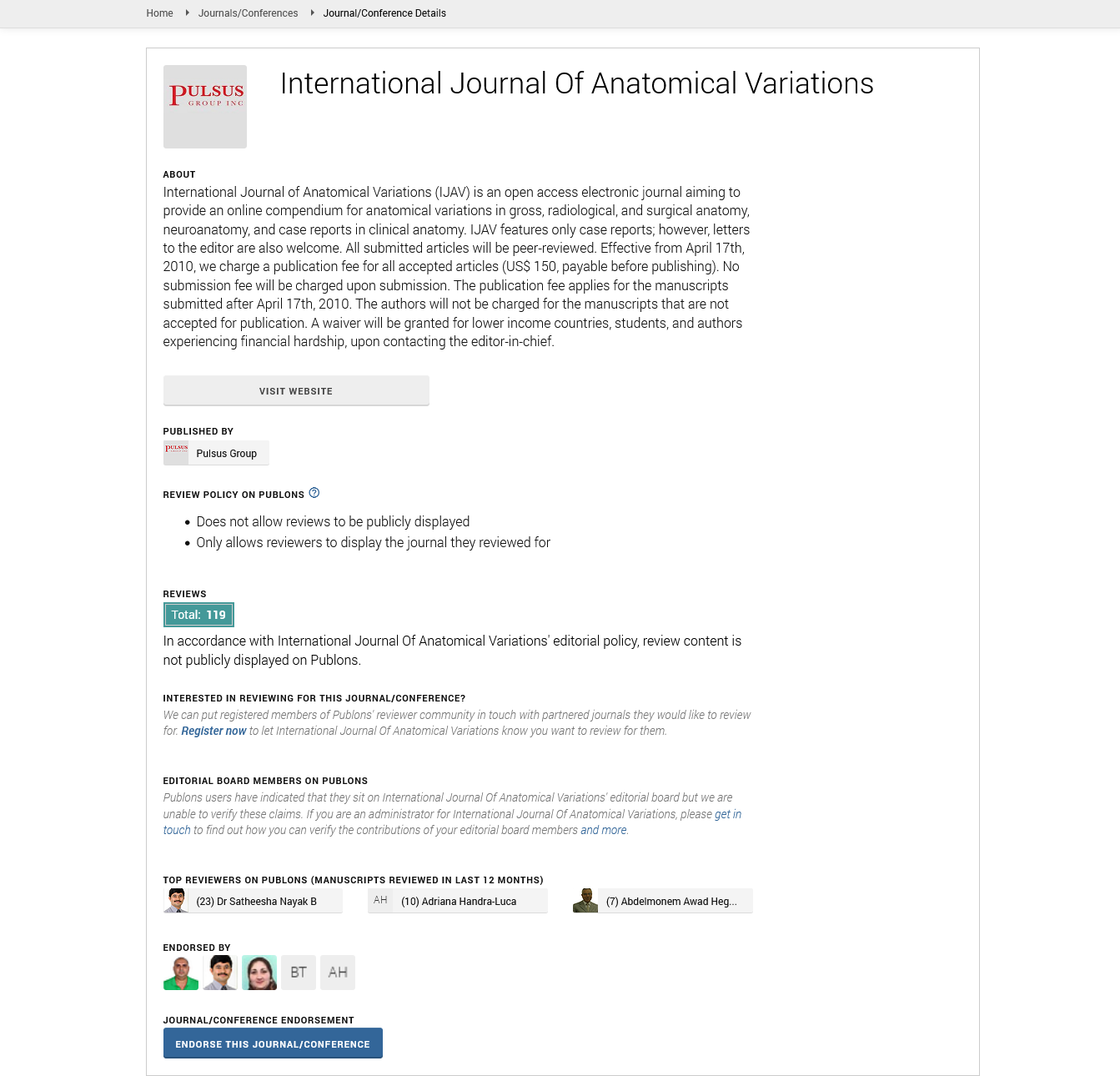Radiological Anatomy A Comprehensive Review of Its Evolution Clinical Relevance and Educational Integration
Received: 01-Feb-2025, Manuscript No. ijav-25-7622; Editor assigned: 04-Feb-2025, Pre QC No. ijav-25-7622 (PQ); Reviewed: 19-Feb-2025 QC No. ijav-25-7622; Revised: 26-Feb-2025, Manuscript No. ijav-25-7622 (R); Published: 28-Feb-2025, DOI: 10.37532/1308-4038.18(2).486
Citation: Sahu A. Radiological Anatomy a Comprehensive Review of Its Evolution Clinical Relevance and Educational Integration. Int J Anat Var. 2025;18(2): 739-740.
This open-access article is distributed under the terms of the Creative Commons Attribution Non-Commercial License (CC BY-NC) (http://creativecommons.org/licenses/by-nc/4.0/), which permits reuse, distribution and reproduction of the article, provided that the original work is properly cited and the reuse is restricted to noncommercial purposes. For commercial reuse, contact reprints@pulsus.com
Abstract
Radiological anatomy is a critical field that merges the structural insights of human anatomy with the visual power of medical imaging. It forms the cornerstone of diagnostic radiology, surgical planning, and modern medical education. This review explores the historical development of radiological anatomy, outlines its clinical applications, discusses advances in imaging technologies, and evaluates its integration into medical curricula. Emphasis is placed on the importance of accurate anatomical interpretation in various imaging modalities, the role of radiologists and clinicians, and the future directions driven by artificial intelligence and 3D modeling.
INTRODUCTION
Radiological anatomy refers to the study and understanding of human anatomy as visualized through various medical imaging techniques such as X-rays, computed tomography (CT) [1], magnetic resonance imaging (MRI), ultrasound, and nuclear medicine. Unlike traditional gross anatomy, which depends on dissection and direct observation, radiological anatomy provides a non-invasive and dynamic approach to visualize internal structures. It is indispensable in both clinical practice and anatomical education, offering real-time insights into physiological and pathological conditions [2].
HISTORICAL PERSPECTIVE
The foundations of radiological anatomy were laid in 1895 with Wilhelm Conrad Roentgen's discovery of X-rays. The ability to visualize bones and internal organs without surgery revolutionized medicine. By the mid-20th century, the introduction of cross-sectional imaging such as CT and MRI further deepened the understanding of anatomical relationships. These innovations transformed anatomy from a static to a dynamic science, enabling not just observation but also functional and pathological assessments [3].
IMAGING MODALITIES AND THEIR ANATOMICAL INSIGHTS
X-ray imaging is still widely used due to its speed, accessibility, and diagnostic value in examining bones, chest structures, and gastrointestinal tracts. Radiological anatomy at this level includes the interpretation of skeletal morphology, cardiac silhouettes, and air-filled structures. CT provides detailed cross-sectional images that are particularly useful for evaluating complex anatomical regions like the brain, thorax, and abdomen. The high-resolution images allow clinicians to assess bone fractures, organ pathology, and vascular abnormalities with precision [4].
MAGNETIC RESONANCE IMAGING (MRI)
MRI is superior in visualizing soft tissues and is indispensable in neurological, musculoskeletal, and cardiovascular imaging. It allows for multiplanar imaging and is essential for diagnosing ligament injuries, tumors, and central nervous system disorders [5].
ULTRASOUND
Ultrasound is commonly used in obstetrics, abdominal imaging, and vascular studies. Its dynamic nature helps in the assessment of real-time movement, blood flow, and fetal development, enhancing the practical application of anatomical knowledge.
NUCLEAR MEDICINE
Techniques like PET and SPECT combine anatomy with physiology, offering insights into metabolic activity. These modalities are essential in oncology and functional brain imaging.
RADIOLOGICAL ANATOMY IN MEDICAL EDUCATION
With advances in imaging, radiological anatomy has become an integral part of medical education. Digital imaging, 3D reconstruction, and virtual dissection tools are now incorporated into curricula to supplement cadaver-based learning. This approach improves spatial understanding, diagnostic skills, and clinical reasoning in students.
CHALLENGES IN RADIOLOGICAL INTERPRETATION
Despite technological advancements, interpretation requires extensive training. Misinterpretation can lead to diagnostic errors.
THE FUTURE OF RADIOLOGICAL ANATOMY
AI and machine learning are transforming radiological practices by automating image segmentation, diagnosis, and even anatomy teaching. AI can highlight anatomical landmarks and assist in differential diagnoses.
3D MODELING AND PRINTING
The use of 3D models derived from imaging data aids in preoperative planning and patient education. These models provide tactile feedback and a better sense of spatial orientation.
VIRTUAL AND AUGMENTED REALITY
Immersive technologies offer a new dimension in learning and visualization. Virtual dissection and holographic anatomy models are poised to become standard tools in education.
CONCLUSION
Radiological anatomy stands at the intersection of diagnostic precision and anatomical science. As imaging technology continues to evolve, so does the depth and accuracy with which we understand human structure. From its historical roots in plain radiography to the current applications in AI-enhanced imaging, radiological anatomy remains an essential pillar of modern medicine and education. Investing in its integration, interpretation training, and technological synergy will continue to enhance its impact on healthcare outcomes.
REFERENCES
- Ali A, Mengistu F, Hussen K, Getahun G, Deressa A (2010) Overview of rabies in and around Addis Ababa, in animals examined in EHNRI zoonoses laboratory between, 2003 and 2009. Ethiop Vet J 1491-1501.
- Cleveland S, Kaare M, Tiringa P, Mlengeya T, Barrat J (2003) A dog rabies vaccination campaign in rural Africa: impact on the incidence of dog rabies and human dog-bite injuries. Vaccine 21: 1965-1973.
- Collier L, Oxford J (2006) Human Virology. 3rd ed. Oxford University Press Inc New York, USA. 189-194.
- Abebe A (2012) Major challenges and gaps in rabies prevention and control. In Proceedings of the national workshop on rabies prevention and control in Ethiopia. 18-19.
- Aga AM, Hurisa B, Urga K (2016) Current situation of rabies prevention and control in developing countries: Ethiopia perspective. Infectious Prev Med Infect Dis 4: 1-6.
Indexed at, Google Scholar, Crossref
Indexed at, Google Scholar, Crossref






